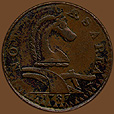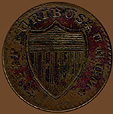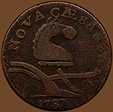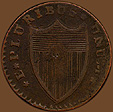New Jersey Coppers 1786-1790
obverse |
|
reverse |
| |||
1787 Maris 54-k Elizabethtown ? Hatfield ? "Serpent Head" counterfeit NJ Copper
Obverse: NOVA CÆSAREA 1787
Reverse: * E * PLURIBUS * UNUM *
Weight: 90.4 g (5.86 grams) Diameter: 28.1 mm Reverse die alignment: 180°
Comments: This interesting counterfeit New Jersey copper is called the "Serpent Head" variety because of the horse's unusually long curved neck with the nose pointed downward, so that it resembles a sea serpent. Like most counterfeits this variety is found on thin lightweight planchets that are far below the authorized weight of 150 grains. It has traditionally been thought this variety may have been made by a man named Hatfield in his barn outside of Elizabethtown (see Introduction). However, the reference to Hatfield suggests he had a very small operation and probably did not own a coining press. Many specialists now conclude the large mintage of Maris 54-k coppers, which was clearly made on a press, was from an undetermined counterfeiting mint.
In addition to the distinctive horse the obverse can be detected by the position of the horse to the left, mostly over the handles of the plow. Also notice the tiny bottom piece on the small singletree at the end of the plow beam. This little bottom piece usually points down diagonally to the right away from the coulter, but in this obverse the piece points down diagonally to the left towards the coulter. Interestingly, in making this die no R punch was available so a P punch was used and a small tail was cut into the die to turn the letter into an R in CÆSAREA.
The obverse also has some die breaks. There is a thin die break from the top of the A in NOVA through the lower part of the letter C and extending to the serif at the start of the AE ligature (Æ) in CÆSAREA. The break is visible on the coin but less noticeable on the scanned image, for the coin is dark in that area. Another die break can be seen on the plow at the bottom of the curve on the beam; the break passes through the coulter and onto the share. Apparently this second break is later than the first for Hodder only mentions the first break in describing the Taylor catalog specimen. This obverse is only found with reverse k.
The reverse is considered to have a shield that is somewhat shorter in length than usual. Also, the left point (dexter point) of the outline around the shield touches the letter U. Additionally, this is an example in which the vertical lines on the shield, the pales, are grouped in three rather than four. As with the obverse no R punch was available so a P punch was used and a small tail was cut into the die to turn the letter into an R in PLURIBUS. This reverse is only joined with obverse 54.
Provenance: From the Robert H. Gore, Jr. Numismatic Collection.
obverse |
|
reverse |
| |||
1788 Maris 56-n Elizabethtown Matthias Ogden Camel Head NJ Copper
Obverse: NOVA CÆSAREA . 1787
Reverse: * E * PLURIBUS * UNUM *
Weight: 102.9 g (6.67 grams) Diameter: 27.7 mm Reverse die alignment: 190°
Comments: Until recently this coin was thought to have been produced at Machin's Mills. Mossman has suggested the dies could have been created by James Atlee at Machin's Mills but they were shipped to Matthias Ogden in Elizabethtown where he used them in his press. Ogden then minted coins without producing planchets, rather he stamped his coins over any coppers he could find that were rated lower than New Jersey coppers. There are three "Camel Head" obverses, Maris 56, 57 and 58; all display a horse with what Maris calls an "arched" mane also they are only combined with reverse n. Obverse 56 can be easily distinguished in that it is the only one of the three obverses where the horse's ears are under the letter C. In fact, the far ear touches the C.
The reverse has a long shield in which the central point is higher than the end points. The top section of the shield with the horizontal lines, know as the chief azure, is larger than usual, that is, it goes further down the shield. Also, the vertical lines on the shield, known as pales, are grouped in three (some varieties have groups of four). There is a die crack from the top left (dexter) point on the shield to the end of the serif on the U; another die crack can be seen further down from the edge of the shield passing just to the left of the E and extending between to denticles to the rim. The obverse of this example has several fisure cracks.
This coin was overstruck on a 1787 Connecticut copper. On the reverse under the UNUM one can see the exergue line of the undertype and the date, with the 87 especially prominent. (click here for reverse detail of the CT date)
Provenance: Purchased through the Robert H. Gore, Jr. Numismatic Endowment from EANA auction of November 16, 1996 - lot 66.
| New Jersey Coppers: p. 2 | Section Contents | New Jersey Coppers: p. 4 |
|
For viewing tips and information on optimal computer settings click
here.
For questions or comments contact Special Collections by: |



